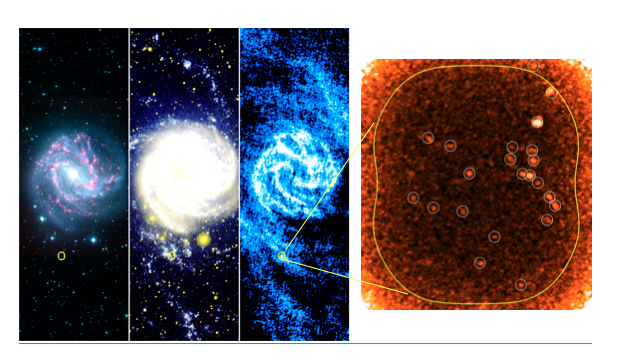The international team of researchers discovered 23 clusters or clusters of small and very dense molecular clouds, which are the sites where stars are formed. This is in a region very far away from the M83 galaxy, a place where stars are no longer visible and were not expected to be found.
“Astronomers are keen to know what the process of star formation is. There is still a question that we must understand: how, where and when new stars are born in the universe. This discovery allows us to advance this process because without stars there is no light, and therefore no evolution in universe,” says Monica Rubio, also a 2021 recipient of the National Prize for the Exact Sciences.
To make this discovery, the ALMA (Atacama Large Array) millimeter radio telescope, located north of Chile in the Atacama Desert, was used, which pointed to the edge of the galaxy M83, where there is a gas composed of hydrogen atoms, one that is incapable of forming stars. But now the emission of a carbon monoxide molecule has been detected.
“These emissions are different from what we normally find in molecular clouds, where a large amount, a large volume of their atmosphere is not visible, and it turns out that we have now been able to detect the core of these small clouds. In general, to form stars we need the regions to be dense, dark and cold,” he says. Rubio, adding, “My contribution to this work was to present my experience on the properties of these clouds found in small galaxies with few components to form them.” Particles, low-metallicity dwarf galaxies.

Research at the far edge of the galaxy M83 reveals unusual star formation in an extremely extreme environment. The area shown in yellow shows data from several different instruments.
From left to right: optical image from CTIO, UV image from GALEX, 21 cm HI image from VLA and GBT, and CO(3-2) from ALMA. In this final image, the “hearts” of star formation appear as molecular clouds, surrounded by a white circle.
Credit: Jane Koda
The search continues
The team now intends to further investigate these new regions in depth and characterize them using the ALMA radio observatory.
This research was a continuation of the work begun by Celia Verdugo, a student of Dr. Rubio who later obtained her doctorate in France, under the supervision of Professor François Combes. The research was expanded by Professor Jim Cuda of Stony Brooks University in New York, who led the research; Along with Amanda M. Lee of the University of Massachusetts Amherst, David Thilker of Johns Hopkins University, Françoise Combs of the Paris Observatory, and Samuel Boissier of the Laboratory of Astrophysics in Marseille, as well as Rubio and other researchers.
The initial discovery was published in the Astrophysical Journal under the title: “First detection of molecular cloud clusters in the extended ultraviolet disk of M83”This represents a major advance in understanding how, when and where new stars are born in the vast universe.
-
To learn more about what's happening in the world of science and culture, join our community Cultívate, El Mostrador's newsletter on these topics. Register for free here.

“Creator. Devoted pop culture specialist. Certified web fanatic. Unapologetic coffee lover.”
